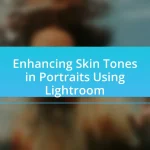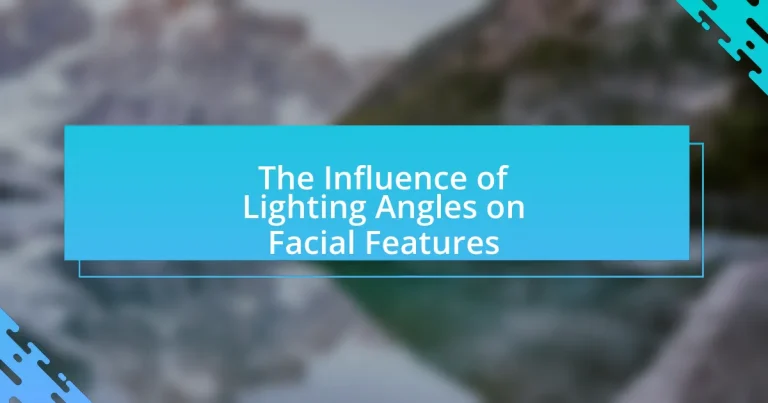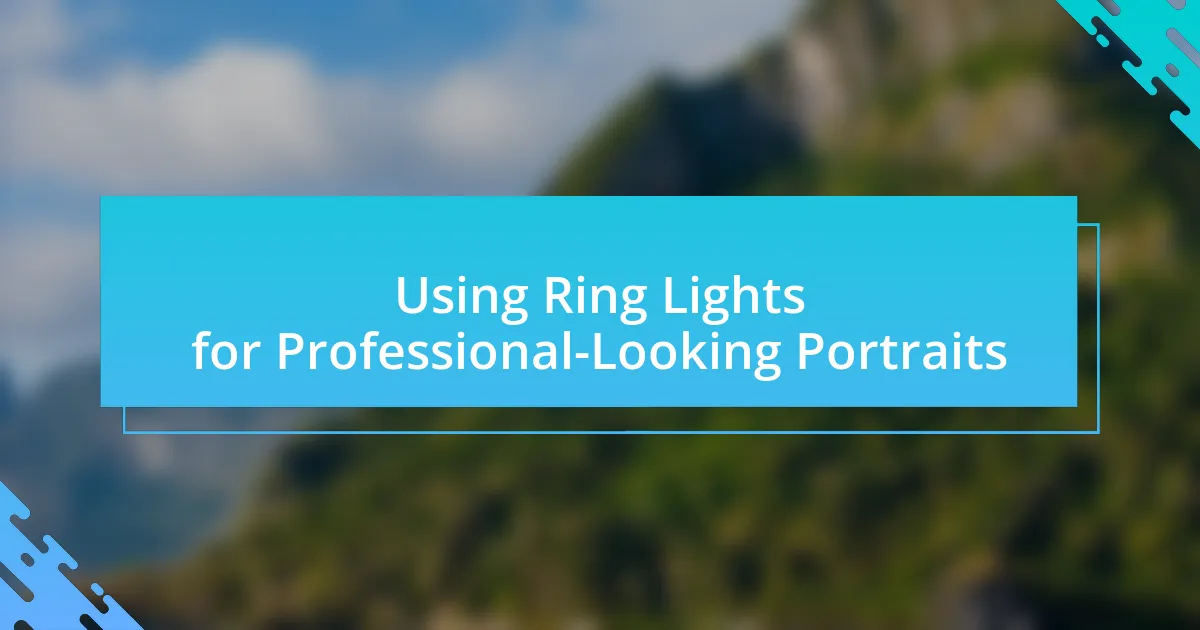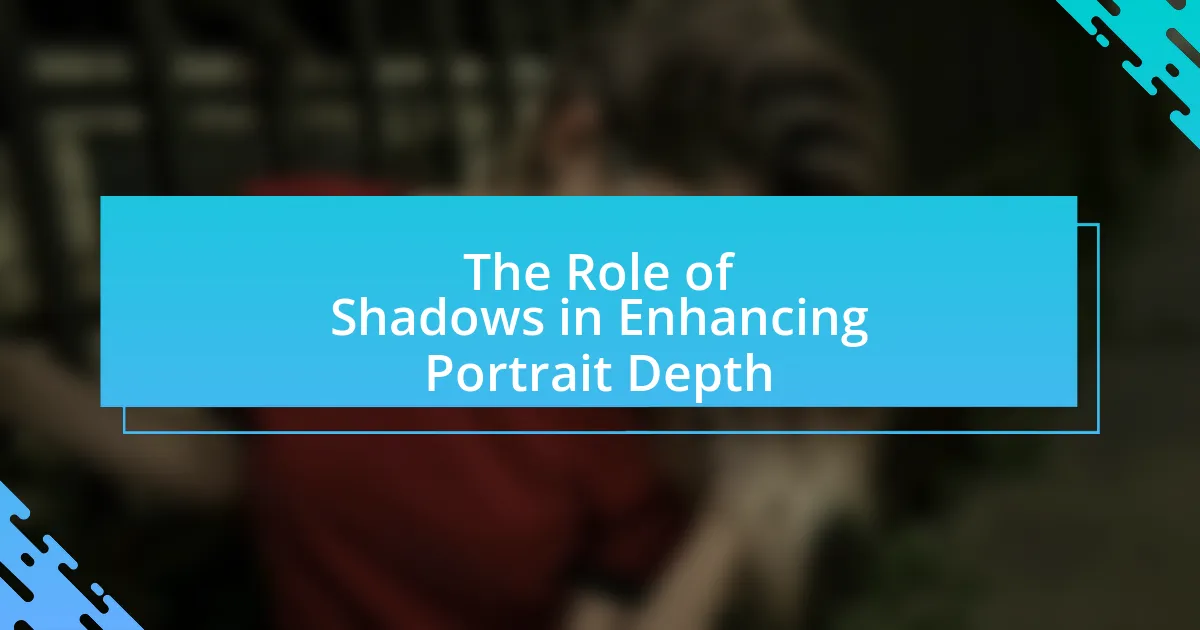The article examines the influence of lighting angles on facial features, highlighting how different lighting setups can alter the perception of shadows and highlights on the face. It discusses the effects of various lighting angles, such as frontal, side, and back lighting, on key facial features like the eyes, nose, cheeks, and jawline. Additionally, the article explores the significance of lighting in photography and videography, emphasizing its role in enhancing or detracting from a subject’s appearance and emotional expression. Practical tips for achieving optimal lighting techniques and common mistakes to avoid are also addressed, providing a comprehensive understanding of how lighting angles impact visual representation.
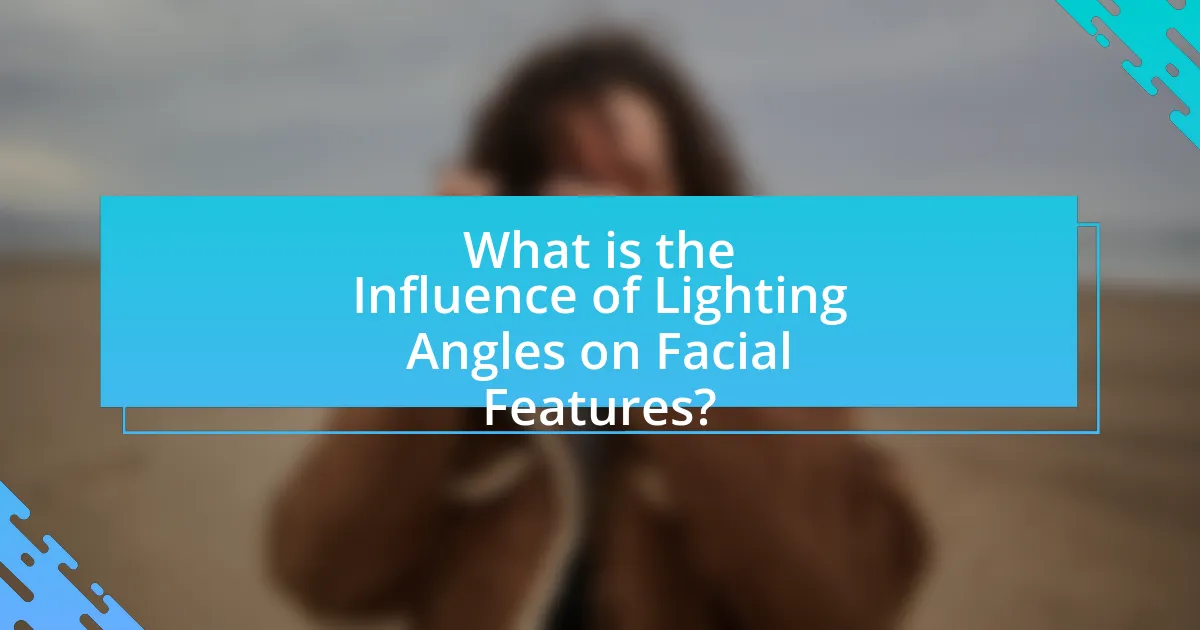
What is the Influence of Lighting Angles on Facial Features?
Lighting angles significantly affect the perception of facial features by altering shadows and highlights. When light is positioned directly in front of a face, it minimizes shadows, creating a flat appearance that can soften features. Conversely, side lighting emphasizes contours and textures, enhancing the definition of cheekbones and jawlines. Research indicates that lighting from above can create dramatic shadows, which may accentuate imperfections or create a more angular look. Studies in photography and cinematography demonstrate that the angle of light can influence emotional expression and attractiveness, as different lighting setups evoke varying moods and perceptions.
How do different lighting angles affect the perception of facial features?
Different lighting angles significantly influence the perception of facial features by altering shadows and highlights on the face. For instance, lighting from above can create pronounced shadows under the chin and nose, which may make the face appear more angular and defined. Conversely, lighting from below can soften features and create an unnatural appearance, often associated with horror or unease. Research indicates that frontal lighting tends to minimize shadows, resulting in a more symmetrical and aesthetically pleasing appearance, while side lighting can enhance texture and depth, emphasizing contours. Studies in photography and psychology demonstrate that these variations in lighting can affect emotional responses and attractiveness ratings, confirming the critical role of lighting angles in shaping perceptions of facial features.
What are the key facial features impacted by lighting angles?
The key facial features impacted by lighting angles include the eyes, nose, cheeks, and jawline. Different lighting angles can create shadows and highlights that alter the perception of these features. For instance, lighting from above can cast shadows under the eyes, making them appear deeper, while lighting from below can create an unnatural look. Side lighting can enhance the cheekbones and jawline, providing definition, whereas frontal lighting tends to flatten the face, reducing the appearance of depth. These effects are well-documented in photography and cinematography, where lighting techniques are crucial for achieving desired visual outcomes.
How does lighting direction alter the appearance of shadows on the face?
Lighting direction significantly alters the appearance of shadows on the face by determining where shadows fall and how pronounced they appear. When light is positioned directly in front of the face, it minimizes shadows, creating a flat appearance. Conversely, when light is angled from the side, it casts deeper shadows, enhancing facial contours and features. For instance, a 45-degree angle light source can create dramatic shadows under the cheekbones and jawline, emphasizing these areas. This effect is supported by studies in photography and cinematography, which demonstrate that varying light angles can dramatically change the perception of depth and dimension in facial features.
Why is understanding lighting angles important in photography and videography?
Understanding lighting angles is crucial in photography and videography because they significantly affect how facial features are perceived. Different angles can create shadows and highlights that either enhance or diminish certain aspects of a subject’s face, influencing the overall mood and aesthetic of the image or video. For instance, a 45-degree angle can produce flattering shadows that define cheekbones, while direct overhead lighting may create unflattering shadows under the eyes. Studies in visual perception indicate that lighting can alter the viewer’s emotional response to a subject, making it essential for photographers and videographers to master lighting angles to achieve desired effects.
How can lighting angles enhance or detract from a subject’s appearance?
Lighting angles can significantly enhance or detract from a subject’s appearance by altering the perception of facial features and creating shadows or highlights. For instance, lighting from above can create harsh shadows under the eyes and chin, which may emphasize imperfections, while lighting from the front can soften features and create a more flattering look. Studies in photography and cinematography demonstrate that a 45-degree angle of light often produces the most aesthetically pleasing results, as it balances highlights and shadows effectively, enhancing the subject’s dimensionality. Conversely, side lighting can exaggerate textures and contours, which may not be desirable in portraiture.
What role does lighting play in creating mood and atmosphere in visual media?
Lighting plays a crucial role in creating mood and atmosphere in visual media by influencing how subjects are perceived and the emotional tone of a scene. Different lighting techniques, such as high-key lighting, create a bright and cheerful atmosphere, while low-key lighting can evoke feelings of suspense or drama. For instance, in film, the use of shadows and highlights can accentuate facial features, altering the viewer’s emotional response. Research indicates that lighting can affect viewer perception; a study published in the Journal of Visual Communication and Image Representation found that variations in lighting significantly impact audience interpretation of a character’s emotional state. Thus, effective lighting design is essential for conveying the intended mood and enhancing the overall narrative in visual media.
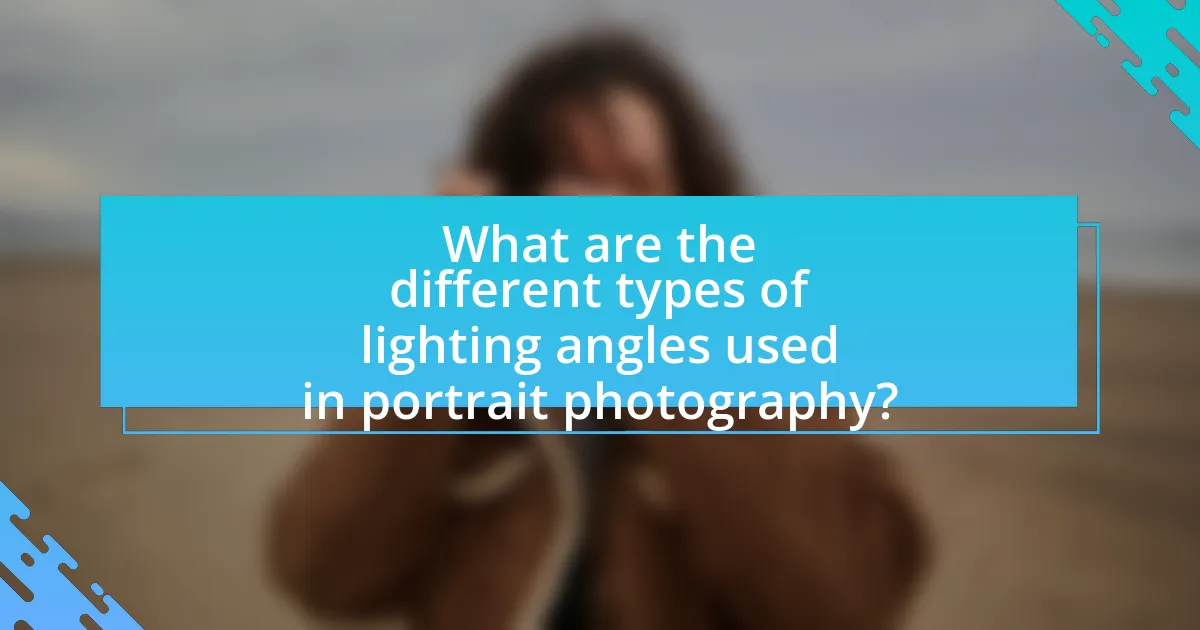
What are the different types of lighting angles used in portrait photography?
The different types of lighting angles used in portrait photography include front lighting, side lighting, back lighting, and overhead lighting. Front lighting illuminates the subject evenly, reducing shadows and creating a flat appearance, which is often used for a natural look. Side lighting creates depth and dimension by casting shadows on one side of the face, enhancing facial features. Back lighting, where the light source is behind the subject, can create a halo effect and emphasize outlines, adding drama to the portrait. Overhead lighting, positioned above the subject, can create strong shadows and highlight the contours of the face, often used in fashion photography to create a specific mood. Each angle affects how facial features are perceived, influencing the overall impact of the portrait.
What is the effect of front lighting on facial features?
Front lighting creates a uniform illumination on facial features, minimizing shadows and highlighting details. This lighting technique tends to flatten the appearance of the face, making features like the nose and cheekbones less pronounced. Studies in photography and visual perception indicate that front lighting can enhance skin texture visibility, often resulting in a more even skin tone. Additionally, research shows that front lighting can lead to a more approachable and friendly appearance, as it reduces harsh contrasts that can create an intimidating look.
How does front lighting influence skin texture and imperfections?
Front lighting significantly influences skin texture and imperfections by creating a flat illumination that minimizes shadows, which can enhance the appearance of smoothness but also highlight flaws. When light is directed straight at the face, it can wash out details, making skin appear more uniform, yet it can also accentuate blemishes, pores, and uneven textures due to the lack of dimensionality. Studies in photography and dermatology indicate that frontal lighting can lead to a more polished look in images, but it may not accurately represent the true texture of the skin, as imperfections become more visible under direct light.
What are the advantages and disadvantages of using front lighting?
Front lighting offers the advantage of illuminating facial features evenly, reducing shadows and creating a flat appearance that can enhance clarity in portraits. This lighting technique is often used in photography and videography to ensure that details are visible and colors appear vibrant. However, the disadvantage of front lighting is that it can lead to a lack of depth and dimension, making subjects appear two-dimensional and less engaging. Additionally, it may highlight imperfections on the skin, which can be undesirable in certain contexts.
How does side lighting impact the perception of depth in facial features?
Side lighting enhances the perception of depth in facial features by creating shadows that accentuate contours and textures. When light is directed from the side, it highlights one side of the face while casting shadows on the opposite side, which visually separates features such as cheekbones, jawlines, and noses. This contrast between light and shadow allows the viewer to perceive three-dimensionality more effectively. Research in visual perception indicates that shadows play a crucial role in depth perception, as they provide cues that help the brain interpret the spatial arrangement of facial features.
What are the visual effects of using hard versus soft side lighting?
Hard side lighting creates sharp shadows and highlights, emphasizing texture and detail on facial features, which can result in a dramatic and intense appearance. In contrast, soft side lighting produces gentle shadows and a more diffused light, leading to a smoother and more flattering representation of the face, reducing the visibility of imperfections. The distinct visual effects stem from the light’s quality; hard light, often from a small source, accentuates contours, while soft light, from a larger source, minimizes harsh lines. This principle is widely recognized in photography and cinematography, where the choice of lighting significantly influences the mood and perception of the subject.
How can side lighting be used to create dramatic portraits?
Side lighting can be used to create dramatic portraits by emphasizing shadows and highlights on the subject’s face, which enhances facial features and adds depth. When light is positioned to the side of the subject, it casts shadows that can accentuate cheekbones, jawlines, and other contours, resulting in a more three-dimensional appearance. This technique is often employed in portrait photography to evoke emotion and create a sense of mystery, as the interplay of light and shadow can convey different moods. Studies in photography demonstrate that side lighting can significantly alter the perception of a subject’s expression, making it a powerful tool for artists and photographers aiming to create impactful imagery.
What is the significance of backlighting in portrait photography?
Backlighting in portrait photography is significant because it creates a halo effect around the subject, enhancing depth and separation from the background. This technique highlights the contours of the face and can produce a more dramatic and ethereal quality in the image. Studies have shown that backlighting can improve the visual appeal of portraits by adding dimension and emphasizing textures, such as hair and clothing, which can lead to more engaging photographs.
How does backlighting affect the outline and shape of facial features?
Backlighting creates a silhouette effect that emphasizes the outline and shape of facial features by casting shadows and reducing the visibility of details. This lighting technique highlights the contours of the face, making features such as the jawline and cheekbones more pronounced while obscuring finer details like skin texture and imperfections. Studies in photography and visual perception indicate that backlighting can enhance the dramatic effect of portraits, as it draws attention to the overall shape rather than individual characteristics, thus altering the viewer’s perception of the subject’s facial structure.
What techniques can be used to balance backlighting with facial illumination?
To balance backlighting with facial illumination, techniques such as using fill light, adjusting exposure settings, and employing reflectors are effective. Fill light, which can be a soft light source placed in front of the subject, helps illuminate the face without overpowering the backlight. Adjusting exposure settings on the camera allows for better control over the brightness of the subject relative to the background. Additionally, reflectors can bounce light onto the face, enhancing facial illumination while maintaining the desired backlighting effect. These methods are widely used in photography and cinematography to achieve a well-balanced image.
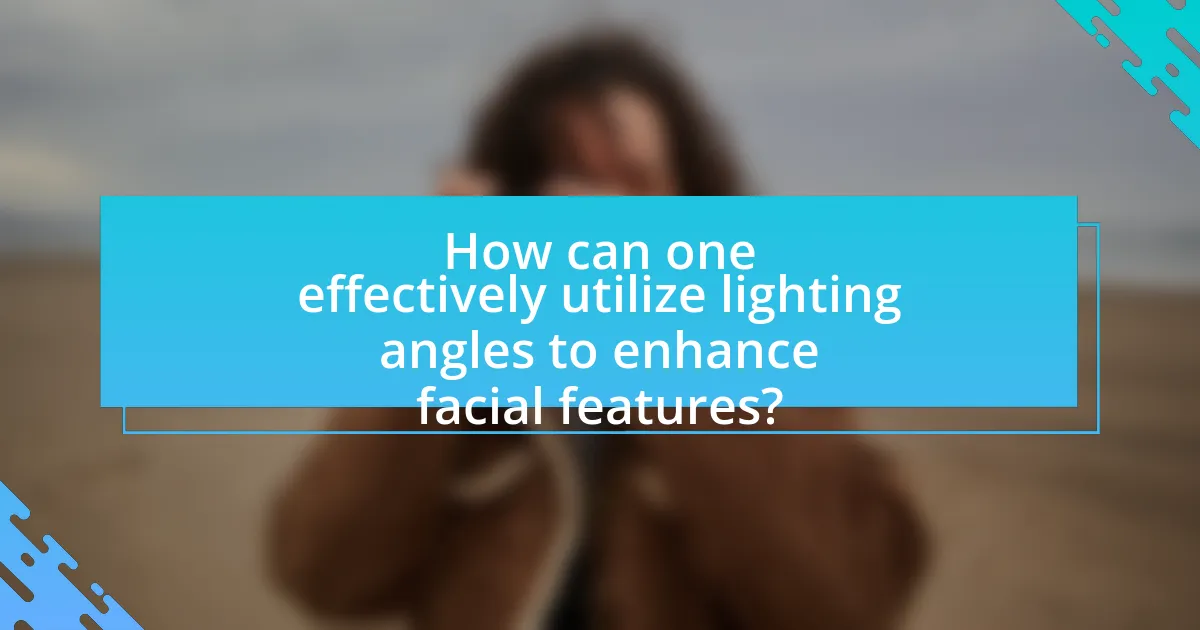
How can one effectively utilize lighting angles to enhance facial features?
To effectively utilize lighting angles to enhance facial features, position the light source at a 45-degree angle to the subject’s face. This angle creates shadows that define the cheekbones and jawline, adding depth and dimension. For instance, using a soft light from this angle can highlight the eyes and soften imperfections, while a harsher light can accentuate textures. Studies in photography emphasize that the direction of light significantly impacts how features are perceived, with side lighting often enhancing contours and reducing flatness in facial appearance.
What are some best practices for positioning lights in portrait photography?
In portrait photography, best practices for positioning lights include placing the main light source at a 45-degree angle to the subject and slightly above eye level to create flattering shadows and highlights. This angle enhances facial features by providing dimension and depth, which is crucial for achieving a three-dimensional look in the image. Additionally, using a fill light on the opposite side can soften shadows without eliminating them entirely, maintaining the natural contours of the face. According to a study published in the Journal of Visual Communication in Medicine, proper lighting angles significantly affect the perception of facial attractiveness, emphasizing the importance of strategic light placement in portrait photography.
How can one experiment with different angles to find the most flattering light?
To experiment with different angles to find the most flattering light, one should systematically adjust the position of the light source relative to the subject’s face. By moving the light source higher, lower, or to the sides, individuals can observe how shadows and highlights change, affecting the perception of facial features. For instance, lighting from above can create dramatic shadows, while lighting from the front tends to soften features. Research indicates that the angle of light significantly influences how facial contours are perceived, with a 45-degree angle often being cited as optimal for enhancing features without harsh shadows.
What tools and equipment can assist in achieving optimal lighting angles?
To achieve optimal lighting angles, tools such as adjustable tripods, light stands, softboxes, reflectors, and diffusers are essential. Adjustable tripods and light stands allow for precise positioning of light sources, enabling photographers to manipulate angles effectively. Softboxes diffuse light, reducing harsh shadows and creating a more flattering illumination on facial features. Reflectors bounce light back onto the subject, enhancing highlights and minimizing shadows, while diffusers soften the light, providing a more even distribution. These tools collectively contribute to achieving the desired lighting effects that influence the perception of facial features.
What common mistakes should be avoided when working with lighting angles?
Common mistakes to avoid when working with lighting angles include improper positioning of light sources, which can create unflattering shadows on the face. For instance, placing the light too high can result in shadows under the eyes and nose, while lighting from below can distort facial features. Additionally, using a single light source without considering fill light can lead to harsh contrasts and loss of detail. It’s also crucial to avoid neglecting the background lighting, as it can affect the overall composition and depth of the image. Understanding these aspects is essential for achieving balanced and aesthetically pleasing results in photography.
How can improper lighting angles lead to unflattering images?
Improper lighting angles can lead to unflattering images by creating harsh shadows and highlights that distort facial features. When light is positioned too high, it can cast deep shadows under the eyes and nose, making the subject appear older or more tired. Conversely, lighting from below can exaggerate features and create an unnatural look. Studies in photography emphasize that optimal lighting should be diffused and positioned at eye level to enhance facial symmetry and minimize imperfections. For instance, a study published in the Journal of Visual Communication in Medicine highlights that lighting angles significantly affect perceived attractiveness and facial aesthetics.
What are the signs of poor lighting in portrait photography?
Signs of poor lighting in portrait photography include harsh shadows, unflattering highlights, and lack of detail in the subject’s features. Harsh shadows can create an uneven appearance on the face, often obscuring important details and leading to a less appealing image. Unflattering highlights may cause areas of the face to appear overly shiny or washed out, detracting from the subject’s natural beauty. Additionally, insufficient lighting can result in a lack of detail, making the portrait appear flat and lifeless. These factors collectively indicate that the lighting setup is inadequate for capturing a well-defined and aesthetically pleasing portrait.
What practical tips can help improve lighting techniques for facial features?
To improve lighting techniques for facial features, position the light source at a 45-degree angle to the subject’s face. This angle enhances the natural contours and creates depth, making facial features more pronounced. Additionally, using diffused lighting, such as softboxes or reflectors, minimizes harsh shadows and evens out skin tones, resulting in a more flattering appearance. Research indicates that lighting direction significantly affects how facial features are perceived, with optimal angles enhancing attractiveness and clarity in photography.











